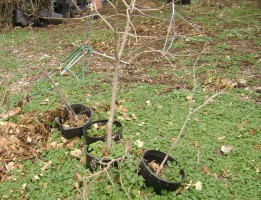by Larry Hummel
Over the years Joan and I have purchased a number of seedling (whips) packages from the Missouri Department of Conservation nursery. Our property is large enough that spring planting involved way too much work in order to provide water to the plants during the summer when both roots and leaves were competing for moisture and nutrients.
The survival rate for whips that are planted in the spring and not watered is reported to be in the 15% range. If you have a small lot and can consistently water the whips during the summer the method I use will be more work than you may need to do. If you do plant the whips in the spring do add some root stimulator, not fertilizer, to the planting.
Fall planting is best
Most trees and shrubs do better when they are planted in the fall except for dogwoods which prefer spring planting. Fall planting with root stimulator added is the preferred method of planting as the whip can spend its energy growing roots not leaves. Sometime around November 1, when the trees have lost their leaves, is the best time to plant.
Trees will grow roots almost all winter depending on the depth of the freeze. Mulch around the tree will improve root development. Deer are another problem for some of us, and they require the tree to be protected by fencing and later by a trunk wrap to prevent bucks rubbing on the tree and branches.
The Hummel method – grow bare-root seedlings in 5-gallon pots
 Joan and I would order the whips in the fall and generally receive them in March before they had developed leaves. I would have some 5-gallon pots available to plant them in. I usually purchased them from Hummert’s in Earth City.
Joan and I would order the whips in the fall and generally receive them in March before they had developed leaves. I would have some 5-gallon pots available to plant them in. I usually purchased them from Hummert’s in Earth City.
It is important for the whips to have good drainage when they are planted in pots. I would put a mixture of earth and mulch/compost in the pot as I was holding the whip in the pot. You can see where the previous planting line is on the whips and I always tried to match the previous planting level.
I would then mulch the top of the plant and add some root stimulator to the pot. In my area I had to fence the whips so deer would not eat them. I would water them every week. I did not fertilize them as I was more interested in root growth than growth of the tree itself.
Planting tips
I would plant the trees around November 1 of the same year or the following year. Sometimes the roots would grow outside of the pot and into the ground around the pot. When this occurred I simply tried to get as much of the roots as possible and cut off the rest.
When planting, put the tree into the ground a little higher than the surrounding ground. In other words don’t put it into a hole. The level of the earth in the pot should be a little higher than the level of the hole. If planted lower you may develop an area that accumulates water and risk drowning the tree. I do not improve the soil I plant in; natives are used to Missouri clay.
This method seemed to work well and the plants did not need as much watering the following summer, although during a long period of dryness I did try to water them. The roots grown during the first winter were at least proportional to the size of the tree and leaf growth, and in most cases large enough to support the tree during the summer. I don’t think the trees require or need any fertilizer until the second spring they are in the ground.


Larry, I’m trying your method with my purchases of MDC whips. I got them in pots before the big snow. Another advantage to those you mentioned is that I’ll have all summer to figure out where I’m going to plant them.
Thank you for the good tips. My whips only got heeled in before we left on our bicycle trip to the south… we will see in a few months how tough the natives might be!!! Or not…thanks again …peace!